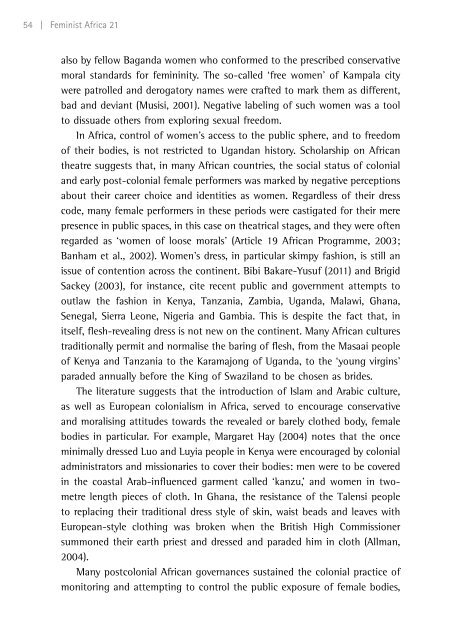The politics of fashion and beauty in Africa
fa21_proof_3
fa21_proof_3
You also want an ePaper? Increase the reach of your titles
YUMPU automatically turns print PDFs into web optimized ePapers that Google loves.
54 | Fem<strong>in</strong>ist <strong>Africa</strong> 21<br />
also by fellow Bag<strong>and</strong>a women who conformed to the prescribed conservative<br />
moral st<strong>and</strong>ards for fem<strong>in</strong><strong>in</strong>ity. <strong>The</strong> so-called ‘free women’ <strong>of</strong> Kampala city<br />
were patrolled <strong>and</strong> derogatory names were crafted to mark them as different,<br />
bad <strong>and</strong> deviant (Musisi, 2001). Negative label<strong>in</strong>g <strong>of</strong> such women was a tool<br />
to dissuade others from explor<strong>in</strong>g sexual freedom.<br />
In <strong>Africa</strong>, control <strong>of</strong> women’s access to the public sphere, <strong>and</strong> to freedom<br />
<strong>of</strong> their bodies, is not restricted to Ug<strong>and</strong>an history. Scholarship on <strong>Africa</strong>n<br />
theatre suggests that, <strong>in</strong> many <strong>Africa</strong>n countries, the social status <strong>of</strong> colonial<br />
<strong>and</strong> early post-colonial female performers was marked by negative perceptions<br />
about their career choice <strong>and</strong> identities as women. Regardless <strong>of</strong> their dress<br />
code, many female performers <strong>in</strong> these periods were castigated for their mere<br />
presence <strong>in</strong> public spaces, <strong>in</strong> this case on theatrical stages, <strong>and</strong> they were <strong>of</strong>ten<br />
regarded as ‘women <strong>of</strong> loose morals’ (Article 19 <strong>Africa</strong>n Programme, 2003;<br />
Banham et al., 2002). Women’s dress, <strong>in</strong> particular skimpy <strong>fashion</strong>, is still an<br />
issue <strong>of</strong> contention across the cont<strong>in</strong>ent. Bibi Bakare-Yusuf (2011) <strong>and</strong> Brigid<br />
Sackey (2003), for <strong>in</strong>stance, cite recent public <strong>and</strong> government attempts to<br />
outlaw the <strong>fashion</strong> <strong>in</strong> Kenya, Tanzania, Zambia, Ug<strong>and</strong>a, Malawi, Ghana,<br />
Senegal, Sierra Leone, Nigeria <strong>and</strong> Gambia. This is despite the fact that, <strong>in</strong><br />
itself, flesh-reveal<strong>in</strong>g dress is not new on the cont<strong>in</strong>ent. Many <strong>Africa</strong>n cultures<br />
traditionally permit <strong>and</strong> normalise the bar<strong>in</strong>g <strong>of</strong> flesh, from the Masaai people<br />
<strong>of</strong> Kenya <strong>and</strong> Tanzania to the Karamajong <strong>of</strong> Ug<strong>and</strong>a, to the ‘young virg<strong>in</strong>s’<br />
paraded annually before the K<strong>in</strong>g <strong>of</strong> Swazil<strong>and</strong> to be chosen as brides.<br />
<strong>The</strong> literature suggests that the <strong>in</strong>troduction <strong>of</strong> Islam <strong>and</strong> Arabic culture,<br />
as well as European colonialism <strong>in</strong> <strong>Africa</strong>, served to encourage conservative<br />
<strong>and</strong> moralis<strong>in</strong>g attitudes towards the revealed or barely clothed body, female<br />
bodies <strong>in</strong> particular. For example, Margaret Hay (2004) notes that the once<br />
m<strong>in</strong>imally dressed Luo <strong>and</strong> Luyia people <strong>in</strong> Kenya were encouraged by colonial<br />
adm<strong>in</strong>istrators <strong>and</strong> missionaries to cover their bodies: men were to be covered<br />
<strong>in</strong> the coastal Arab-<strong>in</strong>fluenced garment called ‘kanzu,’ <strong>and</strong> women <strong>in</strong> twometre<br />
length pieces <strong>of</strong> cloth. In Ghana, the resistance <strong>of</strong> the Talensi people<br />
to replac<strong>in</strong>g their traditional dress style <strong>of</strong> sk<strong>in</strong>, waist beads <strong>and</strong> leaves with<br />
European-style cloth<strong>in</strong>g was broken when the British High Commissioner<br />
summoned their earth priest <strong>and</strong> dressed <strong>and</strong> paraded him <strong>in</strong> cloth (Allman,<br />
2004).<br />
Many postcolonial <strong>Africa</strong>n governances susta<strong>in</strong>ed the colonial practice <strong>of</strong><br />
monitor<strong>in</strong>g <strong>and</strong> attempt<strong>in</strong>g to control the public exposure <strong>of</strong> female bodies,



